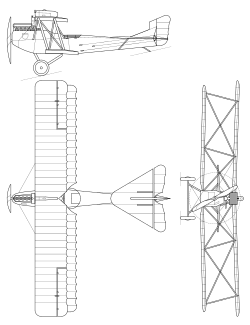Hansa-Brandenburg C.I
| Hansa-Brandenburg C.I | |
|---|---|

| |
| Role | Reconnaissance aircraft |
| Manufacturer | Hansa-Brandenburg |
| Designer | Ernst Heinkel |
| Introduction | 1916 |
| Primary users | Austro-Hungarian Imperial and Royal Aviation Troops Polish Air Force |
| Number built | 1318 |

The Hansa-Brandenburg C.I, also known as Type LDD, was a 2-seater armed single-engine reconnaissance biplane designed by Ernst Heinkel, who worked at that time for the parent company in Germany. The C.I had similarities with the earlier B.I (Type FD, also designed by Heinkel), including inward-sloping interplane bracing struts. Like other early-war Austro-Hungarian reconnaissance aircraft, such as C-types of Lloyd or Lohner, the Type LDD had a communal cockpit for its crew.
The C.I served in the Imperial and Royal Aviation Troops in visual- and photographic reconnaissance, artillery observation and light bombing duties from early spring 1916 to the end of World War I. The aircraft had good handling characteristics, and steady introduction of more powerful engines in successive production batches (see below) enabled the improvement of performance and thus the continuing front-line service.
Armament of the type consisted of a free-firing 8 mm (.315 in) Schwarzlose machine gun at the rear for the observer, and at least in some aircraft for the pilot there was also a similar fixed, non-synchronised forward-firing gun in a pod above the top wing. This latter weapon was replaced in later production examples by a synchronised 8 mm (.315 in) Schwarzlose gun on the port side of the fuselage. The normal bomb load for the C.I was 60 kg (130 lb), but some aircraft could carry one 80 kg (180 lb) and two 10 kg (20 lb) bombs.
Use
Hansa-Brandenburg C.I were used initially by Austro-Hungarian Imperial and Royal Aviation Troops for reconnaissance and bombing during World War I.
After the war, at least 33 machines entered Polish service (some sources indicate 54)[1] and they were used during the Polish-Ukrainian War and Polish-Soviet War. The Hansa-Brandenburg C.I was the first aircraft of the Polish Air Force to complete a combat mission, on 5 November 1918, even before official acknowledgement of the country's independence, during the defence of Lviv.(flown by Stefan Bastyr)[2]
The Hansa-Brandenburg C.I was used by the Royal Air Force of Yugoslavia from 1918 to 1930 as a training aircraft. After retirement from military service they were donated to Aeroclub, received civil registrations and were used for training sports and reserve pilots.
Production
In addition to 84 aircraft built by Hansa-Brandenburg, 400 by Phönix Flugzeug-Werke[3] and 834 by Ungarische Flugzeugfabrik A.G. License production aircraft were built in the following batches:
- Phönix
- Phönix 20.08 & Phönix 20.09 - 150 kW (200 hp) Hiero (V-8?)
- Series 23 and 26 with Austro-Daimler 160hp (120 kW) engine
- Series 27 with Austro-Daimler 185hp (140 kW) engine
- Series 29 with Austro-Daimler 210hp (160 kW) engine
- Series 29.5, 129, 229 and 329 with 150 kW (200 hp) Hiero V-8?
- Series 429 with 170 kW (230 hp) Hiero 6
- Ufag
- Series 61, 64, 67 and 68 Austro-Daimler 210hp (160 kW) engine
- Series 63 with 120 kW (160 hp) Mercedes D.IIIs
- Series 269 Austro-Daimler 210hp (150 kW) engine
- Series 69 with 150 kW (200 hp) Hiero V-8?
- Series 169 with 160 kW (220 hp) Benz Bz.IVas
- Series 369 with 170 kW (230 hp) Hiero 6
- Aero (Czechoslovakia) post-war
Aero A-14, Aero A-15 and Aero A-26 with 138 kW (185 hp) BMW IIIas built by Walter Engines
Operators
- Polish Air Force (post-war, at least 33)
- Czechoslovakian Air Force (post-war)
- Hungarian Air Force (post-war)
- Royal Romanian Air Force (post-war)
- Yugoslav Royal Air Force (post-war)
Specifications (Hansa-Brandenburg C.I Series 23)

General characteristics
- Crew: 2, pilot and observer
Performance
- Endurance:~ 3 hours
Armament
- 1 or 2 × 8 mm (.315 in) Schwarzlose machine gun(s)
- Up to 100 kg (220 lb) of bombs
See also
Aircraft of comparable role, configuration, and era
Notes
- ^ Krzysztof Chołoniewski, Wiesław Bączkowski (in Polish), Samoloty wojskowe obcych konstrukcji 1918-1939 [Military aircraft of foreign designs 1918-1939]. Warsaw, WKiŁ, 1987. ISBN 83-206-0566-0, p. 9
- ^ Tomasz Kopański (in Polish), Lotnictwo w obronie Lwowa w listopadzie 1918 roku [Aviation in Lviv defence in November 1918], Militaria i Fakty nr. 6/2001, p.40
- ^ Haberfellner, Wernfried; Walter Schroeder (1993.). Wiener-Neustädter Flugzeugwerke GmbH. -{AT}--Graz: Weishaupt. ISBN 3-7059-0000-5.
References
- Munson, Kenneth - Bombers, Patrol and Reconnaissance Aircraft 1914 - 1919 ISBN 0-7537-0918-X
- Keimel, Reinhard (1981). "Die Heeresflugzeuge der k.u.k Luftschifferabteilung bzw. der k.u.k. Fligerkompanien von 1909 - 1918". Oesterreichs Luftfahrzeuge-Gschichte der Luftfahrt von den Anfaengen bis Ende 1918. AT-Graz: H.Weishaupt Verlag. pp. 320, 321. ISBN 3-900310-03-3.
- Haberfellner, Wernfried; Walter Schroeder (1993). Wiener-Neustädter Flugzeugwerke GmbH. AT-Graz: Weishaupt. ISBN 3-7059-0000-5.
- Angelucci, Enzo; Paolo Matricardi (1976). Flugzeuge von den Anfängen bis zum Ersten Weltkrieg. Wiesbaden. ISBN 3-8068-0391-9.
{{cite book}}: CS1 maint: location missing publisher (link) - Janić, Čedomir (2011). Short History of Aviation in Serbia. Beograd: Aerokomunikacije. ISBN 978-86-913973-2-6.
{{cite book}}: Invalid|ref=harv(help); Unknown parameter|coauthors=ignored (|author=suggested) (help)
External links
- A page about Hansa-Brandenburg C.I in Polish Air Force service (in Polish).
- Ханза Бранденбург Ц.1 (in Serbish)
